Sydney sock pattern is now available
June 3, 2008: Edited to reflect pattern updates.
Sydney Sock pattern

Sydney sock
This sock gets its name from the arch of twisted sitches at the top of the pattern motif which reminds me of the Sydney Opera House. The 1x1 rib in the diamond motifs slopes towards a line of double decreases in the center and the diamonds are separated by yarn overs.
Sydney is worked toe-up, beginning with a provisional cast on and a short row toe. The unique gusset and slip stitch heel flap construction does not require picking up stitches, and the sewn cast off provides a neat finish with plenty of stretch.
I hope you won't be put off by the number of pages in this pattern. I wanted to make Sydney accessible to as many knitters as possible so I included charts for each size as well as written instructions for the stitch patterns.
Size
Woman’s medium (large), fits approx US size 7-8 (9-10) shoe
Cuff length measured to top of heel flap: 6-3/4 (7) inches
Materials
Gauge
16-1/2 sts & 23 rnds = 2x2 inches stockinette
Errata/Edits
Designer's Notes
7 pages?!
Techniques for Knitting Sydney
The Yarn
In search of: stretch
Lifelines
Avoiding the purl at the beginning of a needle
YO at the beginning of a needle
The charts
The heel flap
Questions?
Related posts:
New and improved Sydney
Sydney on the horizon
Sydney in Panda Wool
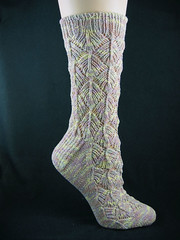 Sydney - Medium Color: Antique | 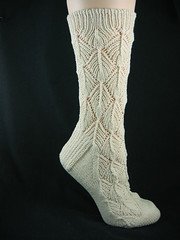 Sydney - Large Color: Corn |
 | 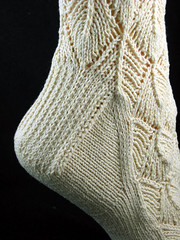 |
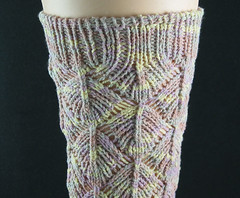 | 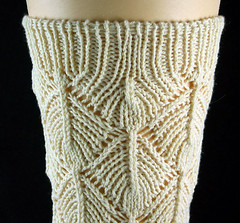 |
 Sydney - Medium Color: Corn | |
 Back detail |
Sydney Sock pattern

Sydney sock
This sock gets its name from the arch of twisted sitches at the top of the pattern motif which reminds me of the Sydney Opera House. The 1x1 rib in the diamond motifs slopes towards a line of double decreases in the center and the diamonds are separated by yarn overs.
Sydney is worked toe-up, beginning with a provisional cast on and a short row toe. The unique gusset and slip stitch heel flap construction does not require picking up stitches, and the sewn cast off provides a neat finish with plenty of stretch.
I hope you won't be put off by the number of pages in this pattern. I wanted to make Sydney accessible to as many knitters as possible so I included charts for each size as well as written instructions for the stitch patterns.
Size
Woman’s medium (large), fits approx US size 7-8 (9-10) shoe
Cuff length measured to top of heel flap: 6-3/4 (7) inches
Materials
- Yarn: Crystal Palace Maizy (82% corn fiber, 18% elastic nylon, fingering weight, 50 gms, 170 yds), 2 (3) balls
- Needles: Set of 5 Crystal Palace Bamboo double pointed needles size 1 (2.25mm) or size needed to obtain gauge
- Fingering weight waste yarn
- Crochet hook (if using a crochet provisional cast on)
- Tapestry needle
Gauge
16-1/2 sts & 23 rnds = 2x2 inches stockinette
Errata/Edits
- 06/03/2008: The pattern has been re-written to add more room at the top of the heel flap, making it easier to pull the sock over your heel. There are more gusset increases, the heel flap is wider, and there are more cuff sts which are worked in a rib up the center back.
Please visit the link above and download the most recent version of the pattern. The pattern notes below have been edited accordingly. - 02/29/2008: Pattern is being updated and will be re-released shortly.
Designer's Notes
7 pages?!
- I've been listening to suggestions and feedback from various sources and the result is a 7 page pattern. Let me take you through it before you decide that 7 pages is too long.
Over half of the pages are the charts and the line by line instructions for those charts. Some people don't like charts, some people aren't comfortable with charts, and some people like written instructions in case there's a question about the charts. I hope what I've provided makes this pattern accessible to a wide range of knitters.
There are 2 sizes. 2 sizes means 4 charts and lots of words. Again, that's more than half of the pages. The description, abbreviations, and photos take up a about half a page.
So the pattern is really ~2-1/2 pages long. Now that's not so bad, is it?
Techniques for Knitting Sydney
- This pattern would work well with either Magic Loop or the 2 circular method. However the double decreases that span 2 needles and the rearranging of stitches might make working 2 socks at a time difficult with either technique.
The Yarn
- When knitting with Maizy, it's a good idea not stretch the yarn too much while knitting. The elastic in Maizy creates stretch in the knitted fabric, so if you stretch the yarn while knitting you'll reduce the stretch of your sock.
In search of: stretch
- This sock went through many changes because the initial stitch pattern did not have enough stretch. The toe and foot fit well, but I couldn't get the sock over my heel. 1x1 ribbing was added to the pattern motif and the updates in the latest version solve the problem.
Lifelines
- When designing socks, I use lifelines whenever I go from one section of the sock to another--after the toe is finished, when gusset increases begin, before and after the heel counter, before starting the cuff. That allows me to rip back and adjust the pattern, needle size, etc., easily. When you knit this sock, I'd suggest at least one lifeline right before you start the gusset increases. This is the round you'll want to rip back to if you want to adjust foot length.
Avoiding the purl at the beginning of a needle
- I don't care for a purl st at the beginning of a dpn. They're completely do-able, but I just don't like them. It dawned on me that I could avoid them completely by purling that st onto my right needle before starting a new needle. For example, on round 1 of Chart A do the double decrease at the end of needle 1, then purl one st from needle 2 onto needle 1. Now start needle 2 with a knit stitch. However, on the next round you need to watch where you put the double decrease. You'll need to start it when you have 3 sts remaining on needle 1, not 2 sts remaining. It probably sounds like gibberish right now. Come back to this note when you're working on the instep and try it out.
YO at the beginning of a needle
- This is easy to do and not something I avoid (unlike purling at the beginning of a needle). Before knitting onto that empty needle, bring the working yarn forward as if you were going to purl. Now take the empty needle and insert it into the first st on your left needle--the empty needle will be over or on top of the working yarn. Take the working yarn over the empty needle towards the back of the work, then knit the st as usual. Bringing the yarn over the needle creates the yarn over. In this pattern it's okay if those yo's at the beginning of the needle are slightly larger than your other yo's. They're at the top of the diamonds and naturally want to be a little bigger.
The charts
- The 1x1 rib pattern in the top half of the motif doesn't look like rib in the charts, it looks more like seed stitch. However, the double decreases take care of that--work the pattern and you'll see that the diagonal lines of knit and purl sts are 1x1 rib. Trust me.
The heel flap
- Sydney's slipped st heel flap is a design element that adds stretch. If you substitute a different style, make sure it has some stretch or you might not be able to put the sock on.
- The heel flap has a twisted st at the beginning and the end of each row. This makes the edges of the heel flap lie flat against the gusset stitches.
Questions?
- Feel free to contact me if you have questions or comments.
knitflix -at- gmail -dot- com
Related posts:
New and improved Sydney
Sydney on the horizon
Sydney in Panda Wool
Labels: corn, Crystal Palace Yarns, pattern, socks
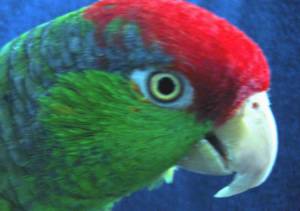
7 Comments:
Congrats! Nice pattern! I've been wanting to try out Maizy for a while now. This is going right into my Ravelry queue!
By theknitist, at 12/12/2007 9:57 AM
theknitist, at 12/12/2007 9:57 AM
So pretty!
By SpinalCat, at 12/12/2007 11:23 AM
SpinalCat, at 12/12/2007 11:23 AM
More awesome socks from Janice! Congrats!
By spinnity, at 12/12/2007 1:09 PM
spinnity, at 12/12/2007 1:09 PM
They are lovely looking socks.
By Alison, at 12/12/2007 4:31 PM
Alison, at 12/12/2007 4:31 PM
I love this pattern!! Sooooo going to cast on for it...as soon as I finish the rest of my holiday knitting.
By Anonymous, at 12/12/2007 5:17 PM
Anonymous, at 12/12/2007 5:17 PM
Thanks Janice for sharing such a gorgeous pattern. I really love the arches in the pattern.It's on my to knit list. Merry Christmas from another Kang from the other end of the world.
By Ann, at 12/13/2007 11:32 PM
Ann, at 12/13/2007 11:32 PM
Jorn Utzon would be impressed with your lovely design!
By Meg, at 12/18/2007 9:32 AM
Meg, at 12/18/2007 9:32 AM
Post a Comment
<< Home